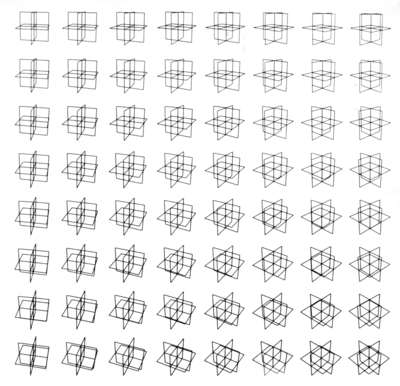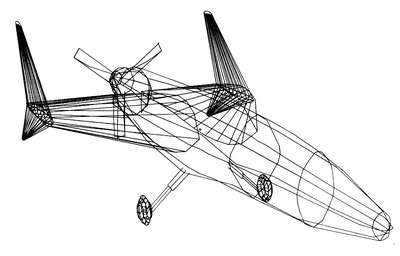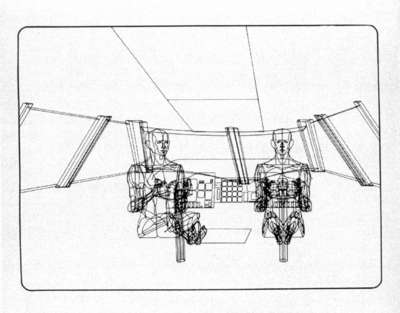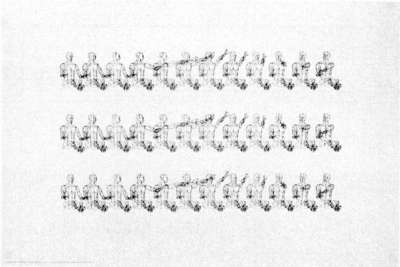“American graphic designer William A. Fetter … introduced the term computer graphics for the new computer based designing technique that he employed as supervisor with the Boeing Company in Wichita (Kansas, USA), and from which Computer Aided Design (CAD) was soon to be developed. CAD stands for the three dimensional shaping of architectural or physical forms with the assistance of the computer. The software of the drawing programmes was developed at the beginning of the 1960s at the Massachusetts Institute of Technology (MIT) in Cambridge (Massachusetts, USA) and is used in construction development. (…)
Numerous drawings and films were produced with three-dimensional wire frame models of pilots, cockpits and aircraft. Although Fetter’s works could be classified as commercially applied art, they were on a high aesthetic standard and were awarded numerous art prizes.” [Herzogenrath et al., 2007]
William Alan Fetter
| i |
| last name: | Fetter |
| first name: | William Alan |
| birthday: | 1928 |
| birth-place: | Independence, MO (USA) |
| death date: | 2002 |
| died in: | Seattle, WA (USA) |
Summary
Biography
| 1928 | William Alan Fetter was born in Independence (Missouri, USA). |
| 1950-52 | designs various publications, exhibitions and posters for the press department of the University of Illinois, where he studied art and graphic design. His interest in using digital computers to solve graphic art problems was stimulated while working as an art director for Family Week in Chicago, where he redesigned the entire magazine. It was there that he began to conceive computer-aided “Dummies” with innumerable transformations. |
| 1959 | takes on a job as a supervisor at the Boeing Company in Wichita (Kansas). This happend before he completed the development of his “Dummies”. |
| 1963 | moves to Boeing in Seattle, Washington. At the Boeing Company, he was head of the department of applied graphic design, and his achievements there gained him a reputation as one of the pioneers of computer graphics: he was the first to draw computer-aided, three-dimensional human figures and moving simulations (at the beginning of the 1960s). Fetter used the computer to enable aeroplane desingers and engineers to visualise different human bodies and a pilot’s restricted vision in the cockpit during landing. He thus contributed greatly to the development of the new Computer Aided Design (CAD), and together with his boss, Vernon Hudson, he coined the term “Computer Graphics” in 1960. The essential difference between his work and contemporary Computer Art was the complete exclusion of chance. Fetter’s work laid the foundation for the subsequent development of computer-generated “Virtual Reality”. |
| 1968 | founds the Northwest chapter of E.A.T., together with LaMar Harrington. |
| 2002 | dies in July, in Seattle (WA, USA). |
Works
 William Alan Fetter
William Alan Fetter
Computer-generated perspective transformations
early 1960
 William Alan Fetter
William Alan Fetter
Experimental Airplane Study
 William Alan Fetter
William Alan Fetter
Fifty Percentile Human Figures Related to Cockpit
around 1966-69
 William Alan Fetter
William Alan Fetter
First Boeing Man
1966-1969
 William Alan Fetter
William Alan Fetter
Panel of Human Figures
around 1966-69
[all 13 entries]

Computer-generated perspective transformations
early 1960

Experimental Airplane Study

Fifty Percentile Human Figures Related to Cockpit
around 1966-69

First Boeing Man
1966-1969

Panel of Human Figures
around 1966-69
References
- Franke, Herbert W. 1971. Computergraphik Computerkunst. Munich:Bruckmann
- Franke, Herbert W. 1972. Computer Art. New Delhi:Mass Communication & Marketing Pvt. Ltd
- Herzogenrath, Wulf & Nierhoff-Wielk, Barbara, eds. 2007. Ex Machina - Frühe Computergrafik bis 1979. Die Sammlung Franke und weitere Stiftungen in der Kunsthalle Bremen. Herbert W. Franke zum 80. Geburtstag. Berlin:Deutscher Kunstverlag
- Klütsch, Christoph 2005. The Summer 1968 in London and Zagreb: Starting or End Point for Computer Art?. In: Creativity & Cognition 05 Proceedings. [unknown address]:ACM press
- Oberquelle, Horst & Beckmann, Oskar 2008. Beckmann's Studio Computers Specified for Early Computer Art. In: IEEE Annals of the History of Computing. Los Alamitos, CA, USA:IEEE Computer Society
Publications
- Fetter, William Alan & Bernhart, W. D. 1970. Planar Illustration Method and Apparatus.
- Fetter, William Alan 1966. Computer Graphics. In: Design Quarterly. [unknown address]:Walker Art Center
- Fetter, William Alan 1982. A Progression of Human Figures Simulated by Computer Graphics. In: IEEE Computer Graphics and Applications. [unknown address]:[unknown publisher]
Comments
enter new comment

